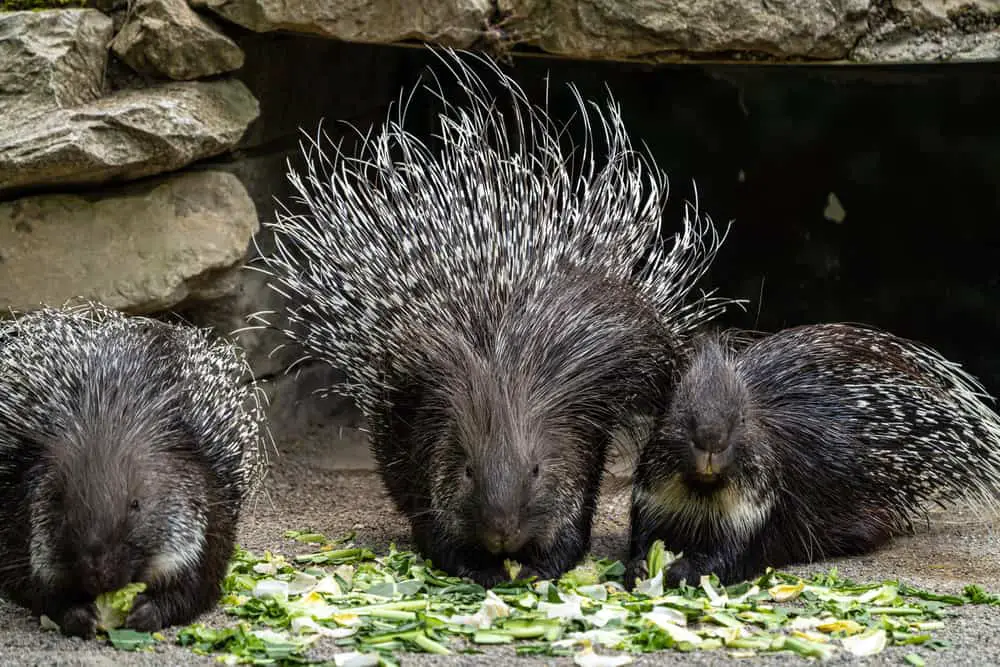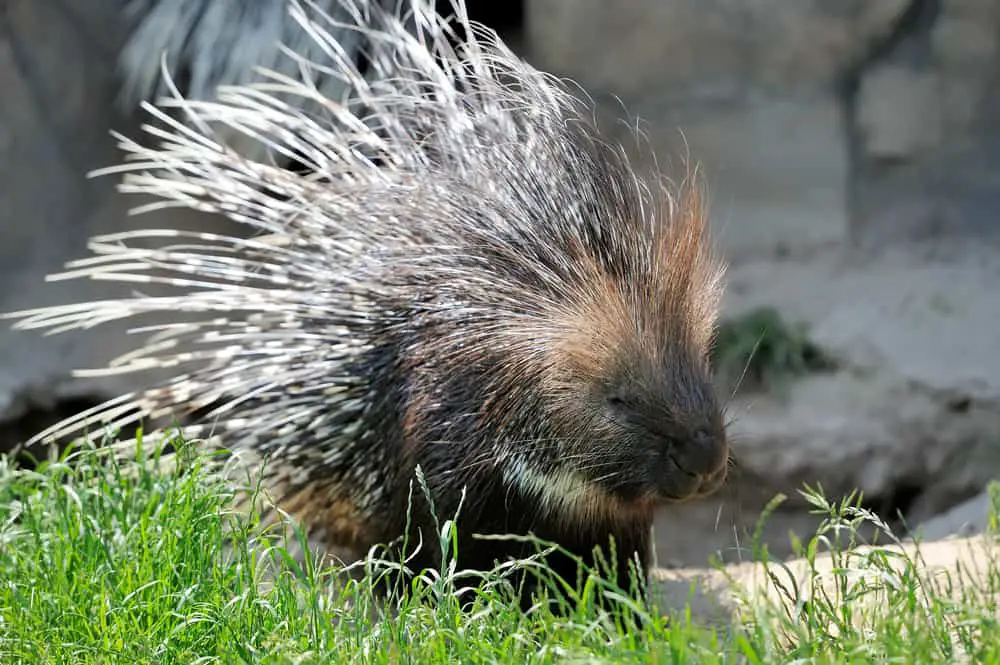Porcupines are fascinating animals that belong to the rodent family. With their characteristic quills, they are easily distinguishable from other mammals.
Porcupines have a widespread distribution throughout North and South America, Europe, Asia, and Africa.
Porcupines are herbivorous creatures that feed on various plant species such as bark, leaves, twigs, fruits, and roots. They possess strong teeth adapted for gnawing through tough vegetation.
These animals exhibit nocturnal behavior and prefer to remain active during the night time. Their slow movements make them an easy target for predators; however, porcupines rely on their sharp quills as a defense mechanism against potential threats.
In this article, we will explore the unique characteristics of porcupines in detail and gain insight into their ecological significance in different regions across the world.

Distribution And Habitat Of Porcupines
| Species | Scientific Name | Distribution |
|---|---|---|
| North American Porcupine | Erethizon dorsatum | North America |
| Crested Porcupine | Hystrix cristata | Europe, Asia, Africa |
| African Porcupine | Hystrix africaeaustralis | Sub-Saharan Africa |
| Indian Crested Porcupine | Hystrix indica | South Asia, Southeast Asia, Middle East |
| Cape Porcupine | Hystrix africaeaustralis | Southern Africa |
| Brazilian Porcupine | Coendou prehensilis | South America |
| Stump-tailed Porcupine | Coendou rufescens | Central and South America |
| Rothschild’s Porcupine | Coendou rothschildi | Central and South America |
| Malayan Porcupine | Hystrix brachyura | Southeast Asia, Indonesia, Philippines |
| Himalayan Porcupine | Hystrix hodgsoni | Himalayan region (India, Nepal, Bhutan) |
Porcupines are a group of rodents that belong to the family Erethizontidae. They inhabit several regions across North and South America, including Canada, United States, Mexico, Brazil, Argentina, among others.
Porcupines have an extensive geographical range due to their adaptability to different environments such as forests, deserts, mountains, and grasslands. Although they prefer living in areas with thick vegetation cover or rocky terrain where they can climb trees and rocks for safety.
Despite being armed with quills that protect them from predators, porcupines still face natural threats like mountain lions, wolves, coyotes, bobcats, lynx and bears. These animals prey on porcupine young ones which lack developed quills during birth or attack adult porcupines by flipping them onto their unprotected bellies.
The attacks often result in injuries or death for both the predator and prey involved since quill penetration can cause severe infections leading to fatal consequences if left untreated. Therefore it is important for porcupines to be cautious when moving around looking for food sources while staying hidden from potential threats lurking nearby.
Anatomy And Physical Characteristics
Despite its prickly demeanor, the porcupine is a fascinating creature with unique anatomical and physical characteristics.
One of the most interesting aspects of this animal is its quills – sharp, rigid hairs that cover much of its body for protection against predators. Interestingly, these quills are modified hairs rather than true spines or needles.
Porcupines also have strong muscles in their back legs which allow them to climb trees with ease. Their front paws feature long claws used for digging up food and climbing as well.
The behavioral traits of porcupines vary depending on species but generally they are solitary animals that only come together during mating season. Speaking of reproduction biology, female porcupines give birth to one offspring at a time after a gestation period of around seven months.
The young are born fully developed with soft quills that harden within hours after birth. While hunting may not be a concern for adult porcupines due to their formidable defenses, it can still be difficult for young ones who rely on camouflage and hiding techniques until they develop stronger quills and survival instincts.
Diet And Feeding Habits
The anatomy and physical characteristics of porcupines are notable for their quills, which serve as a defense mechanism. These sharp spines cover most of the animal’s body except for its underbelly. Porcupines have short legs but are strong climbers, using their prehensile tails to grasp onto branches while they climb trees. They also possess powerful jaws that enable them to chew through tough vegetation.
Despite being well-equipped for self-defense, porcupines are primarily herbivores with specific dietary preferences. They feed on bark, leaves, twigs, and fruit from various plant species depending on availability in their habitat. Their diet consists mainly of coniferous trees such as spruce and pine during winter months when other food sources may be scarce.
Foraging techniques vary between individuals but typically involve climbing up trees or standing on hind legs to reach higher branches where they can find fresh vegetation. Porcupine feeding habits make them important members of forest ecosystems since they help regulate tree growth by keeping populations of destructive insects in check.
Understanding these animals’ diets and foraging behaviors is essential for conservation efforts aimed at preserving their habitats and maintaining healthy forests.
Nocturnal Behavior And Activity
Porcupines are primarily nocturnal animals, meaning they are most active during the night. This behavior is thought to be an adaptation that helps them avoid predators, such as wolves and coyotes.
During the day, porcupines tend to hide in trees or dense vegetation to rest. At night, they come down from their hiding spots to forage for food.
Studies have shown that habitat preferences can influence a porcupine’s nocturnal activity patterns. For example, in areas with high predator populations, porcupines may become more nocturnal and spend more time hiding during the day. In contrast, in areas with low predator populations, they may be less cautious and more active during the daytime hours.
Additionally, mating behavior can also affect a porcupine’s activity patterns. During breeding season (typically late summer/early fall), males will roam further distances searching for receptive females and may exhibit increased levels of activity compared to other times of year.
Overall, understanding the factors that influence porcupine behavior can provide valuable insights into their ecology and conservation needs. By studying how these animals use their environment and interact with each other, we can better protect their habitats and ensure their survival in the wild.
Defense Mechanisms: Quills And Warning Signals
Nocturnal behavior and activity are common traits among many animals, including the porcupine. These creatures have evolved to be more active at night as a way of avoiding predators and conserving energy during hot days. Their nocturnal habits allow them to forage for food in relative safety under cover of darkness.
One of the most distinctive features of porcupines is their quills, which they use as a defense mechanism against potential threats such as humans or other animals. The quills are sharp and barbed, making it difficult for predators to attack them. Additionally, porcupines can release an unpleasant odor when threatened, further deterring potential attackers.
Despite these evolutionary adaptations that help protect them from harm, human interactions with porcupines often lead to negative outcomes. Porcupines may cause damage to gardens or properties and require specialized removal by professionals trained in handling these unique animals safely.
Ecological Significance And Conservation Status
The porcupine plays an important role in the ecosystem as a herbivore. They consume various plants, including bark and leaves of trees. These activities have several ecological functions such as controlling vegetation growth and providing food for other animals like rodents, hawks, eagles, coyotes, cougars among others.
In addition to this ecological significance, porcupines also act as prey species for larger predators which help maintain balance within the predator-prey relationship.
Despite its importance in maintaining natural ecosystems, the porcupine faces threats that impact its conservation status. Habitat destruction due to human development is one of the major factors affecting their survival; deforestation results in loss of food sources and shelter for these animals leading to population decline. Porcupines are also hunted due to their meat and quills which are used in traditional medicine practices or sold illegally on black markets. Roadkill from vehicles also contribute significantly to fatalities among porcupines.
Therefore it’s essential that habitat protection measures be implemented alongside hunting regulations and road safety initiatives to ensure the preservation of this unique animal species for future generations.

Conclusion
Porcupines are fascinating creatures that inhabit regions all over the world, from deserts to forests. These rodents have a unique set of physical characteristics such as sharp quills and long claws that allow them to survive in their environment.
Porcupines primarily feed on plants, including bark and leaves, but they also consume insects and small animals when necessary. Although porcupines are nocturnal animals, they can sometimes be spotted during the day resting high up in trees or perched on rocky outcrops.
They use their sharp senses to detect danger and communicate using vocalizations and warning signals. Despite being slow-moving animals, porcupines possess an effective defense mechanism against predators- their spiky quills which detach easily upon contact with skin.
While some may argue that porcupines mainly cause damage to timber plantations by gnawing at tree barks, these prickly critters play an essential role in maintaining the balance of forest ecosystems. Their feeding habits serve as natural pruning mechanisms for vegetation growth while providing food sources for other wildlife species who depend on them.
However, habitat loss due to deforestation poses a significant threat to porcupine populations globally. Therefore it is crucial that we continue our efforts towards conservation initiatives such as preserving habitats and protecting endangered species like the porcupine.
By doing so, we ensure that future generations can appreciate the beauty of nature’s diversity and prevent further environmental degradation for years to come.

